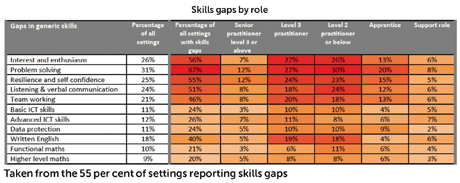
Download this article as a pdf
SKILLS GAPS
More than one in two settings (55 per cent) report skills gaps in their existing workforce, over four times the 13 per cent of employers who report this across the wider economy. An estimated 35,600 early years staff (11 per cent) have skills gaps, compared with 4 per cent across all sectors.

‘Soft’ skills and attitudes are particularly lacking (see table above). A lack of interest/enthusiasm, problem solving, resilience and self-confidence, listening and communication and team working are cited in more cases than formally-taught skills such as maths and English.
Register now to continue reading
Thank you for visiting Nursery World and making use of our archive of more than 35,000 expert features, subject guides, case studies and policy updates. Why not register today and enjoy the following great benefits:
What's included
-
Free access to 4 subscriber-only articles per month
-
Unlimited access to news and opinion
-
Email newsletter providing activity ideas, best practice and breaking news
Already have an account? Sign in here









